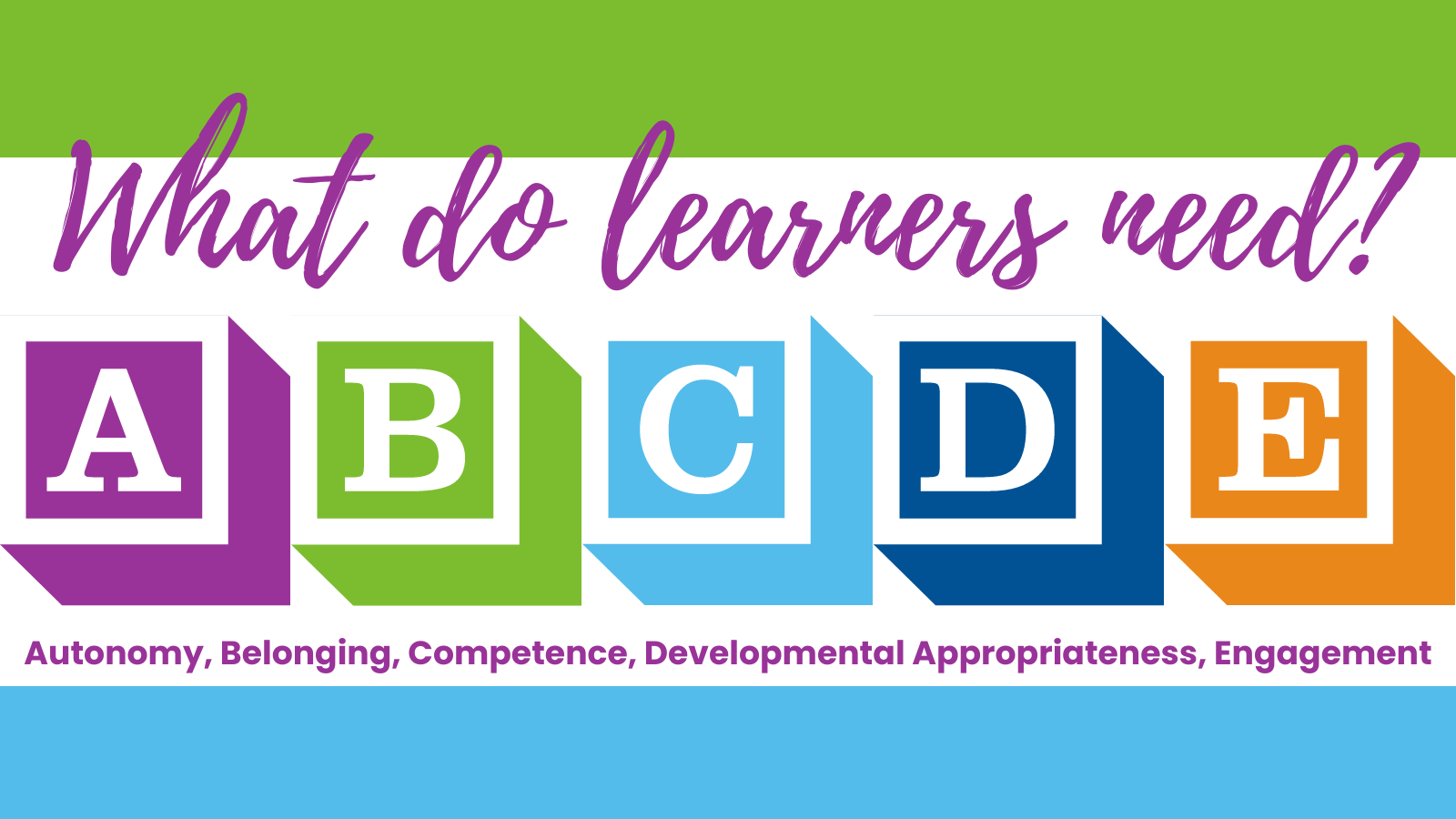If you try this activity with your students, we’d love to see what you do. Share your journey via the #Inspired2Learn hashtag on your preferred social platform.
Discipline: These activities can be applied in any class or subject area.
Age level: All
Time: 5-30 minutes (introducing this concept for the first time will take a while, particularly with young students, but older students will likely pick up the terminology more quickly and then you can use elements of this activity very briefly as a closing in class to get a gauge on where learners are.)
Psychologist William Glasser defined five core human needs “which provide motivation for all that we do.” Framed in the context of children, these needs are Autonomy, Belonging, Competence, Developmental Appropriateness, and Engagement. Children learn and grow best when their needs are met. When they’re not thriving, these unmet needs are often the root of the problem. In this activity you will introduce students to a tool Inspired Teaching created called the ABCDE of learner needs which teachers, and students, can use to evaluate where their needs are and aren’t being met.

What do to:
Start by asking your students what they need in order to learn well in your class. Write down the list they provide as they share it. Their list will likely include several of the elements of ABCDE and if it does not, you might nudge their thinking with questions like:
- What do you need from your classmates?
- What keeps you interested in what we’re doing?
- When you’re having a hard time with something we’re learning, what makes the learning easier for you?
- What helps you focus or pay attention?
- What helps you make good choices?
- When you’ve had a “good day at school” what makes it a good day?
Introduce students to the ABCDE’s of Learner Needs. Discuss what the terminology means. Here are a few handouts can you can use:
- The ABCDE’s Defined (language useful for middle-high school students)
- ABCDE’s Reflection Sheet (language useful for grades 2 and up)
- ABCDE’s Summary Card (designed as a tool for teachers)
In your discussion, work with students to connect their lists and these needs. Explain that these needs were derived from years of research into how human motivation works.
Extension Activities:
- Have students reflect on how well their learning needs are being met right now using this reflection sheet. After they’ve identified their needs along this spectrum invite them to write you a letter explaining what could change in order to better meet their needs.
- Have students reflect on which of the needs they can help their peers fulfill.
- Use the ABCDE framework as a reference when conferencing with students about behavior challenges and discuss what can be done to address unmet needs.
Standards Addressed by these Activities
Common Core College and Career Readiness Anchor Standards for Language
CCSS.ELA-LITERACY.CCRA.L.1 Demonstrate command of the conventions of standard English grammar and usage when writing or speaking.
Vocabulary Acquisition and Use:
CCSS.ELA-LITERACY.CCRA.L.6 Acquire and use accurately a range of general academic and domain-specific words and phrases sufficient for reading, writing, speaking, and listening at the college and career readiness level; demonstrate independence in gathering vocabulary knowledge when encountering an unknown term important to comprehension or expression.
Common Core College and Career Readiness Anchor Standards for Writing
CCSS.ELA-LITERACY.CCRA.W.1 Write arguments to support claims in an analysis of substantive topics or texts using valid reasoning and relevant and sufficient evidence.
Common Core College and Career Readiness Anchor Standards for Speaking and Listening
CCSS.ELA-LITERACY.CCRA.SL.1 Prepare for and participate effectively in a range of conversations and collaborations with diverse partners, building on others’ ideas and expressing their own clearly and persuasively.
Presentation of Knowledge and Ideas:
CCSS.ELA-LITERACY.CCRA.SL.4 Present information, findings, and supporting evidence such that listeners can follow the line of reasoning and the organization, development, and style are appropriate to task, purpose, and audience.
Collaborative for Academic, Social, and Emotional Learning Competencies
Self-management: The abilities to manage one’s emotions, thoughts, and behaviors effectively in different situations and to achieve goals and aspirations. This includes the capacities to delay gratification, manage stress, and feel motivation and agency to accomplish personal and collective goals.
Social awareness: The abilities to understand the perspectives of and empathize with others, including those from diverse backgrounds, cultures, and contexts. This includes the capacities to feel compassion for others, understand broader historical and social norms for behavior in different settings, and recognize family, school, and community resources and supports.
Responsible decision-making: The abilities to make caring and constructive choices about personal behavior and social interactions across diverse situations. This includes the capacities to consider ethical standards and safety concerns, and to evaluate the benefits and consequences of various actions for personal, social, and collective well-being.
Relationship skills: The abilities to establish and maintain healthy and supportive relationships and to effectively navigate settings with diverse individuals and groups. This includes the capacities to communicate clearly, listen actively, cooperate, work collaboratively to problem solve and negotiate conflict constructively, navigate settings with differing social and cultural demands and opportunities, provide leadership, and seek or offer help when needed.
